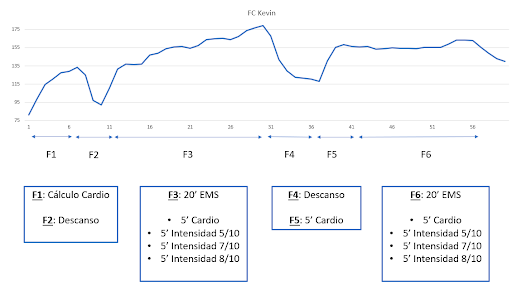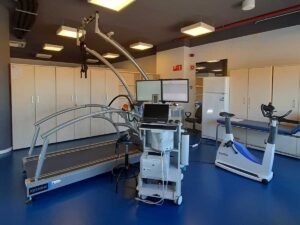In previous blogs we have analyzed the protocol and strategy used to answer this question that arouses so much interest. In this sense, we are going to analyze the heart rate (HR) results detected during the cross-sectional study.
At Wiems Lab we have developed several applications of Electrostimulation with the aim of knowing the derivation of the heart rate that occurs at different electrical frequencies. Through the use of computer calculators, we have been able to find out what the increase in the heart rate of the participants has been for each moment of the test.
As we have explained in previous studies, the participants performed a “warm-up” that from now on we will call “Cardio”, and 15 minutes of Electrostimulation at the corresponding frequency. In those 15 minutes the intensities were:
- 5 minutes at 5/10 on the comfort perception scale (RPE).
- 5 minutes at 7/10 on the comfort perception scale.
- 5 minutes to 8/10 on the comfort perception scale.
As this RPE value increases, the degree of comfort decreases. The objective of this study is to analyze the heart rate during cardio and during the different intensities, and to be able to show the results obtained and compare them.
Assessment of Heart Rate Variation
In order to evaluate this increase in frequency, at Wiems Lab we have designed some templates that help us, on the one hand, to collect data and, on the other hand, to disseminate and understand the results. For example, in the following image we find a summary of the sessions that the participants proposed and their evolution:

Here, we have a summary table of a participant in which we see the evolution of his heart rate throughout the test. Likewise, we have the phases through which it has passed at each moment where the calculation of the intensity of “Cardio”, rest and EMS are perfectly defined.

In this image we can see the heart rate data during cardio, during the application of WB-EMS at 7 Hz and at 21 Hz, the RER and RPE data of each participant, as well as the % change in heart rate for each intensity.

In this other image we can see that this subject obtained an average heart rate without WB-EMS of 132 bpm. When the “Cardio” was performed again, the heart rate rose to 138, and that with the application of EMS at 7 Hz it obtained an elevation of:
- + 19 ppm at an intensity of 5/10 (13.77%).
- + 27 ppm at an intensity of 7/10 (19.57%).
- + 42 ppm at an intensity of 8/10 (30.43%).
Likewise, we can see that during the beginning of the second part of the protocol, the person starts with a high heart rate, that is, 155 bpm, 17 beats above what he started at the beginning of the protocol. This elevated heart rate at the beginning may be the explanation why we did not find such a significant elevation with respect to 7 Hz. In this case, by applying WB-EMS at 21 Hz we have:
- + 0 ppm at an intensity of 5/10 (0%).
- + 9 ppm at an intensity of 7/10 (7.10%).
- + ppm at an intensity of 8/10 (30.43%).
Results
The main objective of this study was to analyze the % change in heart rate that occurred with different electrical frequencies, and based on different intensity levels. To do this, we had to average the changes observed for all the participants. Here we find a few:

We can see that the % increase in heart rate is different depending on the order of application:
- For example, we see (in orange) that when 7 Hz is used first at all intensities (5/10, 7/10, and 8/10) the % change is greater than when it is applied second.
- We can see that at an intensity of 8/10 when we use 7 Hz first, the heart rate increases by 30-37%, however…
- … When we use the 7 Hz frequency in the second place it increases between 10 and 22%.
- Something similar happens with 21 Hz (in purple) for all intensities. If we compare the use of the 21 Hz frequency first or second, we see that the % change in heart rate is different.
- Thus, when we use 21 Hz in the first place, the increase in heart rate is greater than if we use it in the second.
These data can help us understand that, when we use an electrical frequency, it will have an impact on the effect of the second frequency that we use, and that if we want to reach a target heart rate, we will have to regulate the electrical intensity to achieve it.
What does electrostimulation contribute to this process?
Electrostimulation, as we know, is a tool used to involuntarily contract muscles. So much so, that EMS has an effect on increasing heart rate. In this sense, in the project that we have discussed today, electrostimulation plays a fundamental role. We have found that the application of different electrical frequencies has to be structured in a way that takes into account the previous heart rate elevation, and the electrical frequency to be used afterwards.
Conclusion
This study that we have carried out has helped us to draw 3 clear conclusions:
- The heart rate is higher at 7 Hz than at 21 Hz, regardless of the order of application.
- The first block of EMS applied has a greater response in the increase in heart rate.
- The best strategy to raise the heart rate during the first minutes of training is to apply 7 Hz.
At Wiems Lab we will continue to investigate the increases in heart rate that can be caused by other frequencies and in another order of application.
Unai Adrian Perez de Arrilucea
Wiems Lab Team







